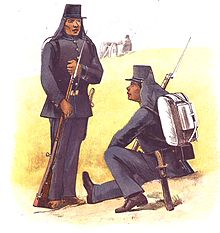Belanda Hitam
Belanda Hitam means something like "Black Dutch" and is the name for African soldiers and their descendants, coming from the Indonesian island of Java , who were responsible for the Koninklijk Nederlandsch-Indisch Leger , the Dutch colonial army , in the 19th century in what was then the Dutch East Indies ( today Indonesia ) have fought. These Africans came from what was then the Gold Coast (today's Ghana ) and had come into Dutch service via the Dutch possessions in the local town of Elmina . Between 1831 and 1872 around 3,000 Africans were brought from Elmina to Batavia (today's Jakarta ), the capital of the Dutch East Indies. After their service time, the smaller part of the Belanda Hitam returned to Elmina, but the majority stayed on Java. Many of them, in turn, moved to the Netherlands as Dutch citizens after Indonesia's independence in 1947 . Therefore, today there are people in both the Netherlands and Indonesia who call themselves Belanda Hitam and trace their origins back to these 3,000 Africans. Since 2013, the Elmina Java Museum, a small museum in Elmina, has been commemorating the history of Belanda Hitam.
Reasons for recruiting African soldiers
The main reason for recruiting Africans for the Dutch army was their acute shortage of recruits as a result of the popular uprising in Java from 1825-1830. In addition to 200,000 Javanese, around 8,000 European and significantly more local soldiers on the Dutch side fell victim to this war. Then there was the defection of Belgium from the Netherlands in 1830, which further reduced the number of potential recruits. It was also assumed that soldiers from tropical Africa would be less susceptible than Europeans to the tropical diseases of "East India". However, this assumption turned out to be wrong. Like Europeans, more African soldiers died from disease than on the battlefield.
Recruitment process
The recruitment of Africans should explicitly take place without coercion. In a first phase from 1831–1836, the Dutch persuaded King Elminas to advertise their recruitment project among his subjects with reference to a secure income, the opportunity to see the world and with the prospect of old-age security. Around 100 men, particularly from Afro-European families from Elminas and Accras , were recruited for the Dutch colonial army during this phase.
In 1837–1841 the Dutch attempted to recruit on a larger scale through the king (" Asantehene ") of the Ashanti Empire , traditionally associated with the Netherlands - from whom the Dutch used to obtain slaves until the slave trade was abolished. Their goal was to recruit 2,000 to 3,000 recruits. The Asantehene promised 1,000 recruits within a year and received 2,000 rifles in advance with the promise of 4,000 more rifles. However, the recruitment was nowhere near as successful as hoped. The laws of the Ashanti Empire forbade subjects from serving in a foreign army, and the Ashanti only delivered some of their slaves to the Dutch. The Dutch's own efforts were far more successful. Slaves received an advance on their wages if they signed up and could buy themselves out with it. A total of around 2,100 Africans left Elmina as recruits for the Dutch during this period.
In a third recruiting phase between 1860 and 1872 there were another 800 young men. In 1872, however, the Dutch handed over their possessions on the Gold Coast to the English, which also ended the recruiting of recruits on the Gold Coast. Between 1890 and 1915, however, the Dutch still recruited a few people in independent Liberia for their colonial army.
The returnees in Elmina
After their contracts expired, some of the soldiers returned to Elmina. There they were assigned parcels behind the Dutch Fort Coonradsburg (today's Fort Sao Jago da Mina ) on a hill that is still called " Java Hill " today. At St. George's Castle, the veterans also received their pensions. But today there is no longer any group that can be identified as descendants of the Dutch colonial soldiers. The memory of this shared Ghanaian-Indonesian history has been kept alive in Elmina for some time by its own Elmina Java Museum .
The Belanda Hitam on Java
The African soldiers who remained on Java fared differently. Within the colonial army, there was a stipulation that a maximum of half of the active people were allowed to be locals. The Africans were counted among the Europeans. They had been promised that in the army they would be given full equality with the European soldiers (which meant a privilege over the native soldiers). They were therefore sensitive to racial discrimination by European officers and there were several mutinies among African units, especially in 1840/1841. The only African who achieved officer rank in the Dutch Colonial Army in the 19th century was Lieutenant Pieter Hermans. Nevertheless, they soon integrated themselves largely into Indo-European society, adopted the Dutch language and became the ancestors of the Indo-African communities in the Javanese towns of Purworedjo , Semarang , Salatiga and Solo . In their families, military service became a family tradition for the Dutch. They fought the Japanese invaders in the Second World War and the independence movement afterwards on the islands of Indonesia . Since they had all received Dutch citizenship, they could choose between staying in Java and moving to the Netherlands after Indonesia's independence. Most of them decided to live in the Netherlands.
literature
- Ineke van Kessel: Zwarte Hollanders. Afrikaanse soldiers in Nederlands-Indië . KIT Publishers, Amsterdam 2005, ISBN 90-6832-498-5 .
Individual evidence
- ^ Elmina - Java Museum . elwininternational.com. Retrieved November 16, 2011.
Web links
- http://elwininternational.com/about_us___company_info.html (overview)
- http://elwininternational.com/java_revolts.html (detailed information on the 1841 revolt)

